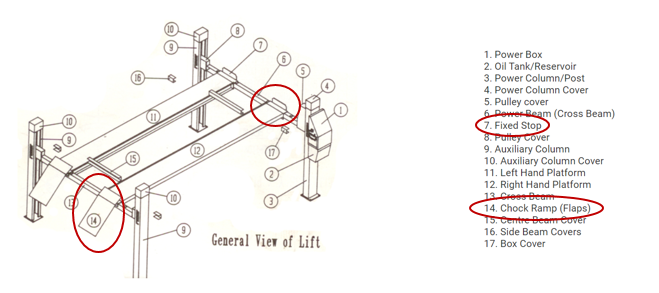Vehicle hoist fatality
The purpose of this Safety Alert is to highlight the risk of serious injury or death when using a vehicle hoist.
Background
In October 2019 a workplace fatality occurred, involving a modified vehicle hoist.
The 4 post vehicle hoist was in an elevated position with a vehicle positioned on top of the wheel platforms. The worker was standing under the hoist conducting mechanical repairs. His upper body was between the under carriage of the vehicle and the front section of the hoist when the vehicle unexpectedly rolled forward along the wheel platforms.
The forward movement of the vehicle resulted in the front wheels of the vehicle dropping off the front of the hoist. The worker was crushed and trapped between the vehicle under carriage and the front cross beam of the hoist.

Image: the vehicle partially fallen from vehicle hoist and the wheel stops recovered at site.
Contributing factors
- Unsafe modifications to the hoist – removal of wheel stops
- Poor maintenance and inspection – a number of serious safety issues were identified during inspection of the hoist by a competent person.
- Unsafe work procedures – inadequate controls to prevent the vehicle from rolling while on the hoist.
Safety components
The design of vehicle hoists require workers to position themselves directly under suspended vehicles to carry out mechanical work. It is crucial that all safety components are operational and fit for purpose to ensure worker safety.
Wheel stops are a safety component of the vehicle hoist involved in this workplace fatality. Wheel stops prevent a vehicle from rolling off the ends of the wheel platforms. Tragically the wheel stops were not fitted to the hoist when this incident occurred.

Image: Diagram provided for illustration purposes only (ref: Automotive Workshop Services)
Action required
- Ensure vehicle hoists are installed and commissioned by a competent person in accordance with manufacturer’s specifications.
- Modifications or repairs must only be conducted by competent authorised persons and records must be kept.
- Operators must inspect vehicle hoists for defects prior to use.
- Conduct functional tests of safety components prior to working under suspended load.
- Operate and maintain hoist in accordance with manufacturer instructions.
- Arrange inspection by an independent competent person at least annually.
- Provide adequate training, information, instruction and supervision to hoist operators.
- Maintain records such as log book for hoist maintenance, inspection and use.
Further information
- Vehicle hoist manufacturer safety and operation manual.
- AS/NZS 2550.9:1996 Cranes – Safe use – Part 9 Vehicle hoists
- AS/NZS 1418.9 Cranes (includes hoists and winches) Part 9 Vehicle hoists
- Work Health and Safety (National Uniform Legislation) Act 2011 and Regulations
- Code of Practice - Managing the risk of plant in the workplace